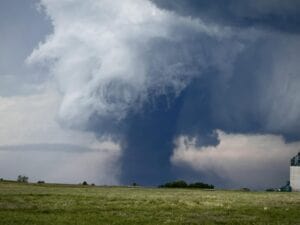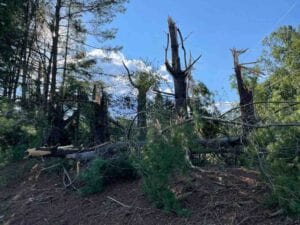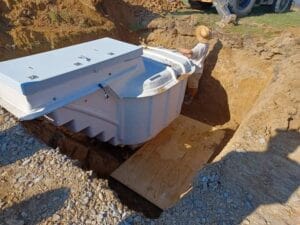Did you know that mobile homes are sitting ducks often housing a significant portion of the population, are highly vulnerable to these destructive forces of nature. The news is riddled with stories of mobile homes torn apart by raging twisters, leaving behind a trail of devastation and potential injuries or even fatalities.
Mobile Home Tornado Safety
The idea here is simple: understanding the unique risks associated with mobile home tornadoes is crucial for preparedness. We need to grasp the gravity of the situation and take action accordingly. With their flimsy construction, mobile homes stand little chance against the ferocity of a tornado’s wrath. It’s time to cut to the chase and recognize that we must be proactive in safeguarding ourselves and our communities from this perilous threat.

So, let’s delve into the world of mobile home tornadoes, exploring their impact on vulnerable populations and assessing what steps we can take to mitigate their potentially catastrophic consequences.
Importance of Tornado-Proofing Your Mobile Home
Tornadoes are powerful and destructive natural disasters that can cause significant damage to homes and properties. Their lightweight construction makes them particularly vulnerable to tornadoes. However, by taking proactive measures to tornado-proof your mobile home, you can minimize potential damage and increase the chances of survival.
Minimizing Damage During Severe Storms
Tornado-proofing your mobile home is crucial in minimizing damage during severe storms. One effective way to achieve this is by reinforcing the structural elements of your home. Strengthening the roof, walls, and foundation can significantly enhance its ability to withstand strong winds and flying debris.
Securing loose items both inside and outside your mobile home is also vital. During a tornado, even small objects can become dangerous projectiles that can cause harm or further damage. By properly anchoring furniture, appliances, and other belongings, you reduce the risk of them being thrown around or through windows.

Increasing Chances of Survival: Mobile Home Tornado Safety
The main goal of tornado-proofing your mobile home is to increase the chances of survival for you and your loved ones. Taking proactive measures such as installing a storm shelter or safe room can provide a designated space where you can seek refuge during a tornado warning.
In addition to securing the structure itself, it’s essential to have an emergency plan in place. Discuss evacuation routes with your family members and establish a designated meeting point in case you get separated during the chaos of a storm. Prepare an emergency kit with essential supplies like food, water, flashlights, batteries, and a first aid kit.
Personal Safety First
Above all else, protecting yourself and ensuring personal safety should be your priority. Stay informed about weather conditions by regularly monitoring local news channels or using weather apps on your smartphone.
When a tornado watch or warning is issued for your area, take immediate action. Seek shelter in a sturdy building or follow your emergency plan if you don’t have access to a suitable structure. Remember, it is always better to be safe than sorry.
By tornado-proofing your mobile home and taking necessary precautions, you significantly reduce the risks associated with these powerful storms. While no measure can guarantee complete safety, being prepared and proactive can make all the difference.
So, reinforce your mobile home’s structural elements, secure loose items, establish an emergency plan, and prioritize personal safety above all else. By doing so, you are taking crucial steps towards increasing your chances of survival during severe storms.
Safety Measures for Mobile Homes During Tornadoes
Identifying a safe location within or near your mobile home is vital during tornadoes.
Mobile homes are particularly vulnerable due to their lightweight construction and lack of a solid foundation. However, by taking the right safety measures, you can increase your chances of staying safe during these destructive storms.
The first step in ensuring your safety is to identify a safe location within or near your mobile home. If you have access to a sturdy building nearby, such as a community storm shelter or a neighbor’s house, that should be your primary choice. These structures offer better protection against high winds and flying debris.
If seeking shelter outside of your mobile home is not possible, there are still some steps you can take to improve safety within the confines of your own dwelling. Look for an interior room without windows, such as a bathroom or closet, on the lowest level of the mobile home. This will help minimize the risk of injury from broken glass and other debris.
Mobile Home Tornado Safety
To further enhance protection, consider reinforcing this designated safe spot with additional measures. Install sturdy locks on doors leading into the chosen room and reinforce them with heavy-duty bolts if possible. Reinforcing windows with storm shutters or even plywood can also provide an extra layer of defense against flying objects.

Creating an emergency plan and practicing it regularly ensures quick action when needed.
In the chaos of a tornado warning, having an emergency plan in place is crucial for reacting swiftly and effectively. Sit down with your family members or household occupants to develop an evacuation strategy and ensure everyone understands their roles and responsibilities.
Start by designating a meeting point outside of the mobile home where everyone will gather in case of an evacuation. This could be a neighbor’s house or another predetermined location that is easily accessible. Make sure all family members know how to get there quickly and safely.
Create a communication plan so that everyone can stay in touch during an emergency. This could involve exchanging phone numbers, setting up a group chat, or using a walkie-talkie system. Regularly practicing these communication methods will help everyone feel comfortable and confident in their use.
It’s also important to pack an emergency kit that is easily accessible in case of a tornado warning. This kit should include essential items such as non-perishable food, water, flashlights, batteries, a first aid kit, and any necessary medications. Keep the kit in a designated spot where it can be quickly grabbed on your way to the safe location.
Staying informed about weather conditions through reliable sources helps in making informed decisions.
During tornado season, staying informed about weather conditions is paramount to making well-informed decisions regarding your safety. Rely on trusted sources of information such as local news channels or reputable weather websites for updates on severe weather watches and warnings.
Consider installing a weather app on your mobile device that provides real-time alerts for your area. These apps often utilize GPS technology to send notifications directly to your phone when dangerous weather is approaching. Take advantage of this technology to receive timely updates even when you’re away from home.
In addition to official sources, pay attention to signs of impending severe weather such as darkening skies, strong winds, or the sound of approaching sirens.
Preparing Your Mobile Home for Severe Storms
Living in a mobile home can be a convenient and affordable housing option, but it’s important to take extra precautions when severe storms, such as tornadoes or hurricanes, are on the horizon. By following these steps, you can help protect your mobile home and keep yourself safe during extreme weather conditions.

Clearing the surrounding area from potential projectiles reduces the risk of damage during tornadoes.
One of the first things you should do is ensure that your surroundings are clear of any objects that could become dangerous projectiles in high winds. Take a walk around your mobile home park and remove any loose items, such as lawn furniture, potted plants, or toys. These items can easily get swept up by strong winds and cause significant damage to your home or neighboring properties.
Consider trimming tree branches that hang over your mobile home. During a storm, these branches can break off and crash into your roof or windows. By proactively addressing this issue beforehand, you can minimize the risk of structural damage.
Installing storm shutters or impact-resistant windows adds an extra layer of protection against high winds.
To fortify your mobile home against severe weather conditions like tornadoes or hurricanes, consider installing storm shutters or impact-resistant windows. These measures provide an additional layer of protection by preventing debris from shattering glass windows and potentially causing harm to residents inside.
Mobile Home Tornado Safety
Storm shutters come in various designs, including accordion-style shutters that fold neatly beside windows when not in use or roll-down shutters that offer quick deployment with minimal effort. Impact-resistant windows are made with laminated glass layers that stay intact even if shattered by flying debris. Both options significantly reduce the chances of damage caused by external forces during severe storms.
Regular maintenance checks on the roof, doors, and windows help identify vulnerabilities that need attention.
Mobile homes are susceptible to leaks and other vulnerabilities due to their construction materials and design. To ensure your home is well-prepared for severe storms, conduct regular maintenance checks on the roof, doors, and windows.
Inspect your roof for loose or damaged shingles that could be easily torn off by high winds. Replace any missing or damaged shingles promptly to prevent water leaks during heavy rainstorms.
Check the seals around doors and windows for any gaps or cracks that may allow water or wind to penetrate. Applying weatherstripping or caulking can help reinforce these areas and keep them secure during severe weather events.
By staying proactive with maintenance checks, you can identify vulnerabilities in advance and address them before they become major issues during a storm.
What to Do Inside a Mobile Home During a Tornado: Mobile Home Tornado Safety
When a tornado strikes, it is crucial to prioritize your safety and seek shelter immediately. For individuals residing in mobile homes, taking the right precautions can make all the difference. Here are some essential steps to follow when seeking refuge inside a mobile home during a tornado:
Seek shelter in the sturdiest part of your mobile home
The first and most important step is to find the safest area within your mobile home. Identify a small interior room or bathroom that offers better protection against strong winds. These areas tend to have reinforced walls and are less prone to collapse.
Use mattresses or heavy furniture for added protection
To enhance your safety, utilize mattresses or heavy furniture as additional coverings. Place them over yourself as you take shelter in the designated area. This will provide an extra layer of defense against potential flying debris that could cause harm.
Avoid areas with large windows or exterior walls
During a tornado, windows and exterior walls are vulnerable points that may collapse under the force of strong winds. It is crucial to avoid seeking shelter in such areas as they pose significant risks. Instead, opt for an interior room with no windows or limited exposure to external walls.
While seeking refuge inside your mobile home during a tornado, it’s important to remember that these structures are generally less secure than traditional houses due to their lightweight construction materials. However, by following these guidelines, you can increase your chances of staying safe:
Keep emergency supplies readily available: Prepare an emergency kit containing essentials like water, non-perishable food items, flashlights, batteries, and a first aid kit.
Stay informed: Monitor local weather reports on television or through reliable online sources so you can be aware of any severe weather warnings issued for your area.
Have an evacuation plan: In case conditions worsen rapidly or if authorities advise evacuating mobile homes during severe storms, ensure you have a plan in place. Identify nearby shelters or the homes of friends and family where you can seek refuge if necessary.
Practice tornado drills: Regularly conduct drills with your household members to ensure everyone knows what to do and where to go when a tornado warning is issued.
Remember, your safety should always be the top priority during severe weather conditions. By taking these precautions and staying informed, you can minimize the risks associated with tornadoes while inside a mobile home. Stay vigilant, stay prepared, and stay safe!

Key Considerations for Tornado-Proofing Your Mobile Home
Taking into account local building codes and regulations ensures compliance with safety standards.
One of the first steps you should take is familiarizing yourself with the local building codes and regulations. These guidelines are put in place to ensure that homes are constructed to withstand severe weather conditions, including tornadoes. By following these codes, you can have peace of mind knowing that your mobile home meets the necessary safety standards.
To comply with local regulations, consider the following options:
-
Proper foundation: Ensure that your mobile home is securely anchored to a solid foundation. This may involve using concrete footings or piers that extend below the frost line.
-
Structural reinforcements: Strengthening key structural elements such as walls, roof trusses, and connections can significantly enhance your mobile home’s ability to withstand high winds. Consult a professional contractor who specializes in tornado-resistant construction for expert advice on reinforcing these areas.
-
Impact-resistant windows: Installing impact-resistant windows can protect your mobile home from flying debris during a tornado. These windows are designed to withstand strong winds and impacts without shattering.
-
Secure doors: Reinforce exterior doors by installing heavy-duty hinges and deadbolt locks. Consider using storm shutters or impact-resistant doors for added protection.
Reinforcing tie-down systems and anchoring methods enhances stability during high wind events.
In addition to complying with building codes, reinforcing tie-down systems and anchoring methods is crucial for ensuring the stability of your mobile home during high wind events like tornadoes. Here are some options you can explore:
-
Tie-down straps: Replace old or damaged tie-down straps with new ones made from durable materials such as steel cables or synthetic webbing. Regularly inspect these straps for signs of wear and tear.
-
Ground anchors: Install ground anchors that are specifically designed to withstand high winds. These anchors should be embedded deeply into the ground and securely attached to your mobile home’s frame.
-
Concrete footings: Consider adding concrete footings around the perimeter of your mobile home as an additional anchoring method. These footings provide extra stability by preventing lateral movement during tornadoes.
Investing in professional inspections helps identify weak points that require reinforcement.
To ensure maximum protection for your mobile home against tornadoes, investing in professional inspections is highly recommended. Professional inspectors have the expertise to identify potential weak points that may need reinforcement. Here’s why this step is essential:
-
Comprehensive assessment: A professional inspector will thoroughly assess various aspects of your mobile home, including its structural integrity, tie-down systems, roofing, and windows. This assessment will help pinpoint areas that require strengthening.
-
Expert recommendations: Based on their findings, inspectors can provide you with expert recommendations on how to reinforce vulnerable areas effectively. This might involve replacing outdated materials or upgrading specific components to meet current safety standards.
-
Peace of mind: By having a professional inspection done, you can have peace of mind knowing that you’ve taken all necessary precautions to protect your mobile home from tornadoes.
Steps to Stay Safe in Your Mobile Home During a Tornado: Mobile Home Tornado Safety
Monitor Weather Alerts and Establish a Communication Plan
Staying informed about weather conditions is crucial when living in a mobile home prone to tornadoes. Ensure you have access to reliable sources of information, such as local news channels, weather apps, or NOAA (National Oceanic and Atmospheric Administration) alerts. Be vigilant and pay attention to any tornado watches or warnings issued for your area.
It is essential to establish a communication plan with your family members. Discuss how you will stay connected during severe weather situations. Share contact information and designate a meeting place in case you are separated during the storm. Consider using group messaging apps or social media platforms to keep everyone updated on your safety status.
Keep Emergency Supplies Readily Accessible: Mobile Home Tornado Safety
When a tornado strikes, every second counts. Make sure you have emergency supplies readily accessible within your mobile home. Create an emergency kit that includes essential items such as:
-
First aid kit: Stock it with bandages, antiseptic ointment, pain relievers, and any necessary prescription medications.
-
Non-perishable food: Store enough canned goods, protein bars, and other non-perishable food items to sustain you and your family for at least three days.
-
Water: Have an ample supply of bottled water available for drinking and basic hygiene needs.
-
Flashlights: Keep multiple flashlights handy along with extra batteries.
-
Portable weather radio: Having a battery-powered radio allows you to stay informed even if the power goes out.
Ensure that all members of your household know where these supplies are located so they can be easily accessed during an emergency.
You might be interested in our article: Mobile Home Basement: Building & Regulations
Practice Tornado Drills Regularly
Preparing yourself and your family for emergencies through regular tornado drills can make all the difference when seconds matter most. Conduct practice drills at least twice a year so that everyone becomes familiar with the appropriate actions to take during a tornado.
During these drills, identify the safest areas within your mobile home. Seek shelter in a small, windowless room on the lowest level of your home, such as a bathroom or closet. If possible, bring mattresses or heavy blankets to provide additional protection against flying debris.
Practice moving quickly and calmly to the designated safe spot. Teach everyone how to cover their heads with their arms and hands for added protection. Emphasize the importance of staying away from windows and exterior walls.
By regularly practicing tornado drills, you can ensure that everyone in your mobile home is well-prepared and ready to take swift action when a tornado threatens.
Remember, staying safe during a tornado in a mobile home requires vigilance, preparedness, and practice. Stay informed about weather alerts, keep emergency supplies accessible, and regularly conduct tornado drills with your family members. By following these steps, you can enhance your chances of staying safe during severe weather events.
Conclusion: Mobile Home Tornado Safety
To ensure the safety of your mobile home during tornadoes, it is crucial to take proactive measures and make necessary preparations. Tornado-proofing your mobile home is of utmost importance as it can significantly reduce the risk of damage and protect you and your loved ones.
By implementing safety measures specifically designed for mobile homes, you can enhance their resilience against severe storms. This includes reinforcing the structure, securing loose items, and installing storm shutters or impact-resistant windows. Regularly maintaining your mobile home’s foundation and anchoring system is essential to withstand high winds.
Preparing your mobile home ahead of severe storms involves staying informed about weather conditions through reliable sources such as local news or weather apps. Creating an emergency kit with essential supplies like food, water, flashlights, and a battery-powered radio is also crucial.
During a tornado, taking immediate action inside your mobile home can save lives. Seek shelter in the sturdiest part of your home away from windows and exterior walls. If possible, get under heavy furniture or cover yourself with mattresses for added protection.
When tornado-proofing your mobile home, consider factors such as location, climate conditions, and local building codes. Consulting professionals who specialize in manufactured homes can provide valuable insights tailored to your specific needs.
Remember that staying safe in a tornado-prone area requires ongoing vigilance and preparedness. Regularly review and update your emergency plans with family members or neighbors to ensure everyone knows what to do in case of severe weather.
In conclusion, safeguarding your mobile home from tornadoes requires a combination of preventive measures before a storm hits and prompt actions during its occurrence. By following these guidelines and being proactive about protecting yourself and your property, you can minimize the potential risks associated with mobile home tornadoes.
FAQs: Mobile Home Tornado Safety
Can I reinforce my mobile home myself?
While some minor reinforcements can be done by homeowners themselves (such as securing loose items), it is recommended to consult professionals for major structural modifications or anchoring systems.
Are there specific building codes for mobile homes in tornado-prone areas?
Yes, many regions have specific building codes that address the construction and safety requirements for mobile homes in tornado-prone areas. It is essential to adhere to these codes to ensure maximum protection.
What should I include in my emergency kit for a tornado?
Your emergency kit should include essential items such as non-perishable food, drinking water, flashlights, batteries, a first aid kit, necessary medications, a battery-powered radio, and any important documents or identification.
How often should I review and update my emergency plans?
It is recommended to review and update your emergency plans at least once a year or whenever there are significant changes in your household composition or living situation.
Can mobile homes be relocated during tornado warnings?
If you receive an official tornado warning and have enough time, it may be safer to evacuate your mobile home and seek shelter in a designated storm shelter or a sturdy building nearby.
You might also be interested in our articles:
